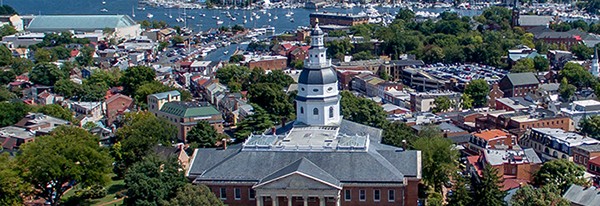Date:
Source: Capital Gazette, Lauren Lumpkin
Efforts to restore the James Brice House in Annapolis are underway, as contractors work to return the historic home’s roof to its 1774 condition.
Almost every piece of the home will be restored to the way it was built in the 18th century, even down to the oyster shell mortar, said Michael Day, vice president of capital projects at Historic Annapolis. Masons have recreated the paste with sand from Spa Creek.
“We identified the sand and matched it with sand in the area,” Day said. “We knew it would have to have come from close by.”
A chemical analysis revealed exactly what kind of mortar was used on the building. It’s made by cooking oyster shells and breaking them down until they become lime. Sand and water are mixed in to produce the mortar.
Day called the undertaking a “labor of love.” The entire restoration process is expected to cost $22 million — a mix of state and private dollars — and take more than three years to complete. The state has poured about $6 million into the project so far, Day said.
Maryland purchased the 250-year-old home in 2014 and Historic Annapolis took over shortly thereafter. A committee of historians, architects, archeologists and other experts determined there was enough documentation to launch a full restoration.
It’s not common for historians to unearth enough information to justify that type of large-scale project, said Day.
“That project in the very beginning started out very small. There was a lot of investigative work that was done,” he said. “Out of those meetings, we figured that this project could actually be a total restoration. It elevated the project to a different standard.”
Much of the home is currently obscured by scaffolding, as contractors repoint bricks and reconstruct the roof. Historic Annapolis has recruited masons, carpenters, painters, woodworkers and other professionals to work on the home.
Some are world-renowned, Day said.
“The project went from a modest millions of dollars to $22 million because when you restore historical material, you have to have the artisans and the conservators associated with the project that really know what they’re doing,” he said.
James Brice wore many hats — farmer, lawyer, politician — and is known for serving as the mayor of Annapolis twice. He did a stint as temporary Maryland governor in 1792.
Brice nearly went bankrupt building his home. Day described an instance when Brice dismantled a newly installed staircase after its design went out of style. His descendants would live in the house for a century.
The 30-room, 2½ story Georgian-style mansion now serves as Historic Annapolis’ headquarters. Day’s office used to be Brice’s master bedroom.
Most of the original structures — such as fireplaces, staircases and doors — have been covered or shipped to storage to prevent any damage. But rooms, including Mrs. Brice’s bedroom and chambers where the Brice’s entertained guests, are intact.
Tight quarters in the attic reveal how enslaved Africans who worked in the Brice household lived. The room is noticeably hotter than the rest of the house.
“It’s a stark reminder of how this house functioned,” said Day.
After the roof is completed, architects will get to work on twin 10-foot chimneys, Day said. Inside, cornices need repair. Each room will eventually get a paint job to match the home’s original design. Some modern fixtures, like recently added cabinets, will be demolished.
“Every day as you’re working on one thing, you might notice something else,” Day said. “These projects are organic.”
The ultimate goal is to open the James Brice House to the public.
“When you have a house like this, that has not really over time been opened to the public but retains so much of its original fabric, if you’re going to show it to the public you want the house to be as authentic as humanly possible,” Day said.
Until then, Historic Annapolis is hosting hard hat tours of the home, starting at the William Paca House at 186 Prince George Street. Tickets are $18.
“The state of Maryland bought this house with the thought of giving it a public purpose,” Day said. “There’s no sense in doing it halfway.”
To view this article on The Capital’s website and view the photos, please click here.


